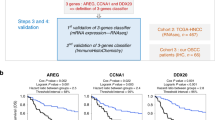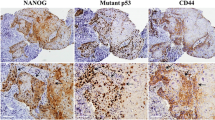Abstract
Higher tumor size correlates with poor prognosis and is an independent predictive survival factor in oral squamous cell carcinoma (OSCC) patients. However, the molecular events underlining OSCC tumor evolution are poorly understood. We aimed to investigate if large OSCC tumors show different cell cycle gene transcriptional signature compared to small tumors. Seventeen fresh OSCC tumor samples with different tumor sizes (T) were included in the study. Tumors were from the tongue or from the floor of the mouth, and only three patients were nonsmokers. Samples were categorized according to clinical tumor size in tumors ≤2 cm (T1, n = 5) or tumors >2 cm (T2, n = 9; T3, n = 2; T4, n = 1). The group of tumors ≤2 cm was considered the reference group, while the larger tumors were considered the test group. We assessed the expression of 84 cell cycle genes by qRT-PCR array and normalized it to the expression of two housekeeping genes. Results were analyzed according to the formula 2^−DeltaCt. A five-fold change cutoff was used, and p values <0.05 were considered statistically significant. Ki-67 immunohistochemistry was performed to estimate cell proliferation index. Twenty-nine genes were downregulated in the test group (larger tumors) compared to the reference group (smaller tumors). Among these genes, 13 reached statistical significance: ANAPC4, CUL1, SUMO1, KPNA2, MAD2L2, CCNG2, E2F4, NBN, CUL2, PCNA, TFDP1, KNTC1, and ATR. Ki-67 labeling index was similar in both tumor groups. Our findings suggest that the transcriptional activity of specific cell cycle genes varies according to the size of OSCC tumor, which probably reflects tumor molecular evolution and adaptation to the microenvironment.



Similar content being viewed by others
References
Ferlay J, Soerjomataram I, Dikshit R, et al. Cancer incidence and mortality worldwide: sources, methods and major patterns in GLOBOCAN 2012. Int J Cancer. 2015. doi:10.1002/ijc.29210.
Patel SG, Shah JP. TNM staging of cancers of the head and neck: striving for uniformity among diversity. Cancer J Clin. 2005. doi:10.3322/canjclin.55.4.242.
Hanahan D, Weinberg RA. Hallmarks of cancer. Cell. 2011. doi:10.1016/j.cell.2011.02.013.
Todd R, Hinds PW, Munger K, et al. Cell cycle dysregulation in oral cancer. Crit Rev Oral Biol Med. 2002. doi:10.1177/154411130201300106.
Stewart BW, Wild CP, editors. World Cancer Report. 3rd ed. Lyon: IARC; 2014.
Helliwell T, Woolgar J. Dataset for histopathology reporting of mucosal malignancies of the oral cavity. London: The Royal College of Pathologists; 2013.
Kademani D, Bell RB, Bagheri S, et al. Prognostic factors in intra oral squamous cell carcinoma: the influence of histologic grade. J Oral Maxillofac Surg. 2005. doi:10.1016/j.joms.2005.07.011.
Arduino PG, Carrozzo M, Chiecchio A, et al. Clinical and histopathologic independent prognostic factors in oral squamous cell carcinoma: a retrospective study of 334 cases. J Oral Maxillofac Surg. 2008. doi:10.1016/j.joms.2007.12.024.
Sobin L, Gospodarowicz M, Wittekind C, editors. TNM Classification of Malignant Tumours. 8th ed. New Jersey: Wiley; 2009.
Bonner JA, Harari PM, Giralt J, et al. Radiotherapy plus cetuximab for locoregionally advanced head and neck cancer: 5-year survival data from a phase 3 randomised trial, and relation between cetuximab-induced rash and survival. Lancet Oncol. 2010. doi:10.1016/S1470-2045(09)70311-0.
Warnakulasuriya S. Prognostic and predictive markers for oral squamous cell carcinoma: the importance of clinical, pathological and molecular markers. Saudi J Med Med Sci. 2014. doi:10.4103/1658-631X.128400.
Tabatabaeifar S, Kruse TA, Thomassen M, et al. Use of next generation sequencing in head and neck squamous cell carcinomas: a review. Oral Oncol. 2014. doi:10.1016/j.oraloncology.2014.08.013.
Cairns RA, Harris IS, Mak TW. Regulation of cancer cell metabolism. Nat Rev Cancer. 2011. doi:10.1038/nrc2981.
Jones RG, Thompson CB. Tumor suppressors and cell metabolism: a recipe for cancer growth. Genes Dev. 2009. doi:10.1101/gad.1756509.
Sullivan GM, Feinn R. Using effect size-or why the p value is not enough. J Grad Med Educ. 2012. doi:10.4300/JGME-D-12-00156.1.
The human protein atlas, http://www.proteinatlas.org
Uhlen M, Fagerberg L, Hallström BM, Lindskog C, Oksvold P, Mardinoglu A, et al. Tissue-based map of the human proteome. Science. 2015. doi:10.1126/science.1260419.
Sun Y. Targeting E3 ubiquitin ligases for cancer therapy. Cancer Biol Ther. 2003. doi:10.4161/cbt.2.6.677.
Acknowledgments
This study was supported in part by the following Brazilian funding agencies: Coordination for the Improvement of Higher Education Personnel (CAPES), Fundação de Amparo à Pesquisa do Estado de Minas Gerais (FAPEMIG), and National Council for Scientific and Technological Development (CNPq), Brazil. Diniz, M.G. is a research fellow at CAPES. Gomez, R.S. and Gomes, C.C. are research fellows at CNPq.
Conflict of interest
None.
Author information
Authors and Affiliations
Corresponding author
Rights and permissions
About this article
Cite this article
Diniz, M.G., de Fatima Correia Silva, J., de Souza, F.T.A. et al. Association between cell cycle gene transcription and tumor size in oral squamous cell carcinoma. Tumor Biol. 36, 9717–9722 (2015). https://doi.org/10.1007/s13277-015-3735-1
Received:
Accepted:
Published:
Issue Date:
DOI: https://doi.org/10.1007/s13277-015-3735-1




